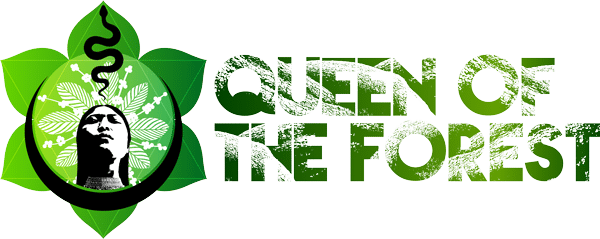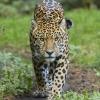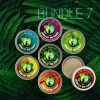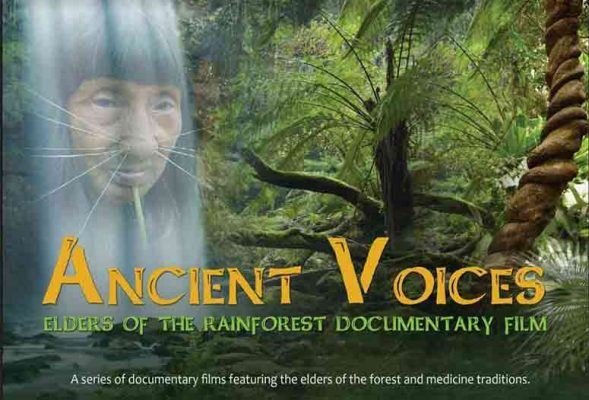Throughout the state of Acre, Amazonas and southern Peru, the indigenous people Huni Kuin always found a cure in nature, thanks to their close relationship with the forest and their millenary knowledge of plants. Grown in their medicinal gardens, different species of plants treat physical and spiritual ailments. Natural solutions that serve anything from stoping a toothache, to helping focus on fishing and hunting, or even putting an end to the misfortune of men and dogs.
 More than 100 species of this therapy are now presented in text and visuals in the recently released “Una Isi Kayawa – Cure Book Huni Kui the Jordan River” (Before Publishing, 260 pages), organized by the shaman Augustine Manduca Matthew Ika Muru and ethnobotanist Alexandre Quinet, a researcher at Rio’s Botanical Garden (a collection of photos of Camilla Coutinho made to the works in the show are “The dream that heals,” displayed at Parque Lage). The publication was an old dream of Manduca shaman, who died in 2011: perpetuated the printed record of the medical culture of his people, before being restricted oral transmission. Fruit of a long process, which included five expeditions to the Jordan River (Acre), interviews with shamans, collection and catalogs of botanical material, as well as resident translators in Rio de Janeiro. The project is an unprecedented exchange of experiences between the National Center Flora Conservation Research Institute of Botanical Gardens and Huni Kuin. It incorporates the application of scientific and technical research of the “white man” to the knowledge of traditional cultures of the Indians.
More than 100 species of this therapy are now presented in text and visuals in the recently released “Una Isi Kayawa – Cure Book Huni Kui the Jordan River” (Before Publishing, 260 pages), organized by the shaman Augustine Manduca Matthew Ika Muru and ethnobotanist Alexandre Quinet, a researcher at Rio’s Botanical Garden (a collection of photos of Camilla Coutinho made to the works in the show are “The dream that heals,” displayed at Parque Lage). The publication was an old dream of Manduca shaman, who died in 2011: perpetuated the printed record of the medical culture of his people, before being restricted oral transmission. Fruit of a long process, which included five expeditions to the Jordan River (Acre), interviews with shamans, collection and catalogs of botanical material, as well as resident translators in Rio de Janeiro. The project is an unprecedented exchange of experiences between the National Center Flora Conservation Research Institute of Botanical Gardens and Huni Kuin. It incorporates the application of scientific and technical research of the “white man” to the knowledge of traditional cultures of the Indians.
The record of plants indigenous therapy follows a mythical division of four groups (Dau, Inani, Inu, Banu). The presentation of spiritual concepts of Huni Kuin (also known as Kaxinawás) is essential for them, since there is no clear separation between science and religion. The use of herbs is accompanied by chants, and the healing process involves an intricate relationship with other living beings.
– “The man’s connection with the plants comes from the early days, when the search for the cure of diseases was directly related to the belief in the power of the forces of nature, particularly the plant world” – notes Quinet. – “The priests were the earliest alchemists, guarding the observations of the herbal uses. Cultures as diverse as that of Huni Kuin Indians, had a magical conception of plants, always related to the enchanted beings of nature, which make up its theogonic worldview.
In the world of Huni Kuin, the influence of the deities can manifest positively – the success in hunting, for example – or negatively – in suffering with illnesses. Part of the cure depends on a sustainable behavior, since the ecological relationships influence the health of men, creating a reaction cycle and revenge of the spirits of plants and animals. Feeding on chicks and damaging them during their dismemberment causes health problems to the hunter. Eating a capybara cub, for example, can cause sudden pain and epilepsy (diseases can be treated by them with baths of amé leaves, Maku txakiwã or Rutaceae in traditional nomenclature).
According to organizers of the book, there is no opposition between the “magic” characters of Huni Kuin knowledge and conventional scientific approach: shamans and scientists operating at different levels of consciousness, but getting the same knowledge of the species. Besides being an endorsement of the Western botanical indigenous knowledge, however, the project is a dialogue between two complementary intelligences, says the publisher Anna Dantes.
– “For Huni Kuin, the plants are sacred; It is a vision that has been lost in the West, but remains in native cultures” – he explains. – “I see that in many places in the West, they seek to recover this connection with the plant world, the understanding that we are nature.”
Translating the complex knowledge of Huni Kuin was a challenge for Anna. In 2008, she edited the “Cabinet of curiosities of Domenico Vandelli”, which presented the universe of an Italian naturalist of the eighteenth century by a more enlightened view. Already an edition of “Book of Healing”, which also includes photographs of Gabriel Rosa and artist Ernesto Neto, among others, aesthetic guides for notebooks and drawings of shamans. Try diagramming windows, free and organic proportions, and use paper made of recycled plastic, which makes it resistant to humid conditions of the forest, which must be distributed.
– “We have been faithful to the concept of the “Living book” designed by Manduca: a dynamic instrument of collective learning that transforms those involved.” – Accounts Anna. – “The photos had to help the taxonomist to identify the plants, but at the same time present them in a language with which the shaman apprentice can identify themselves. The Huni Kuin are always updating their culture, and they wanted to show how the knowledge of the forest can be more valuable than other types of exploitation, such as livestock.
What is the association between painting and new phases in the life of an object or person in Huni Kuin culture?
In Huni Kuin culture, painting with genipap is a practice predominantly carried out by women and is closely connected to new phases in the life of both objects and individuals. While unpainted on regular days, the presence of genipap brought from the forest by the men from the house sparks the eagerness to mix the paint and invite others to engage in the act of painting. The act of painting oneself is most commonly seen among young women, with men participating less frequently unless they are acting as hosts.
The artistic style known as kene kuin manifests a wide array of named motifs. Occasionally, a single motif may have multiple names, reflecting the Huni Kuin aesthetic’s characteristic ambiguity between figure and ground. These motifs, which are observed in face painting, are not limited to the realm of the human body but can also be found in body painting, pottery, weaving, basketry, and stool decorations.
It is important to note that not all objects or individuals are adorned with designs. Cooking vessels, for example, remain unpainted, whereas plates used for serving food may bear designs. Painting is intrinsically linked to a new phase in the life of an object or person, emphasizing the need to highlight the smooth and flawless surface of the subject at hand. The intricate design serves to draw attention to novel visual experiences, signifying the announcement of significant life events. However, these designs tend to fade with use and are only reapplied during festivals. Consequently, objects that bear designs hold a special significance within Huni Kuin culture, mirroring similar customs found in other cultures across western Amazonia.
What is the significance of kene kuin designs in Huni Kuin identity?
The kene kuin designs hold significant importance in shaping the identity of the Huni Kuin community. These designs consist of a wide range of motifs, each having multiple names. The reason behind this is the intentional ambiguity between figure and ground, which is a defining characteristic of the Huni Kuin aesthetic.
Interestingly, these motifs are not limited to one form of expression but are found in various aspects of Huni Kuin culture, such as face painting, body painting, pottery, weaving, basketry, and stool decorations. This integration of the same motifs across different mediums highlights the interconnectedness of these art forms within their cultural practices.
Although not all bodies are painted, nor are all objects adorned with designs, the act of painting is associated with a distinct phase in the life of both objects and individuals. It signifies a new chapter, where the emphasis lies on highlighting the smooth and perfect surface of the subject. The design itself serves as a visual representation that announces and commemorates crucial life events.
It’s noteworthy that the designs are not permanently etched onto the bodies or objects but rather vanish with use. They are reapplied exclusively during festivals, creating a cyclical nature to their presence. This cyclical process reinforces the notion that objects or individuals adorned with these designs hold a special place within the Huni Kuin culture, similar to other indigenous communities of the western Amazonia region.
Overall, the significance of kene kuin designs in the Huni Kuin identity lies in their ability to visually communicate and celebrate important moments in their lives. These designs act as a cultural marker, connecting different aspects of their artistic practices and reinforcing the uniqueness of their community within the broader context of western Amazonia.
What is the significance of the shamanic voyage in Huni Kuin shamanism?
The shamanic voyage holds immense significance in the realm of Huni Kuin shamanism. It serves as an integral practice, wherein the shaman’s consciousness transcends the confines of the physical body through the realms of dreams or induced trances. These journeys encompass a multitude of objectives, extending beyond the mere treatment of a specific illness. They act as exploratory quests, seeking profound understanding of the world and the underlying causes of ailments.
One of the primary purposes of these journeys is to navigate the pathways that the departed spirits, known as bedu yuxin, must traverse on their ascension towards the sky. By undertaking these cosmic sojourns, the shaman enhances their connections with the spiritual realm, thereby benefiting the well-being of the entire community. These voyages broaden the shaman’s knowledge of the intricate dynamics between the physical and spiritual realms, fostering a deeper understanding of the spiritual forces that influence health and disease.
The exploratory nature of these journeys allows the shaman to delve into the depths of the unknown, unraveling the mysteries that lie beyond the material world. Through encounters with spirits, celestial beings, and divine entities, the shaman gains insights into the ultimate truths and fundamental causes that underpin afflictions. This knowledge is not limited to mere physical ailments but extends to the broader implications for the community, providing a framework for healing, harmony, and prosperity.
Additionally, the shamanic voyages serve as transformative experiences for the shaman themselves. These immersive encounters with the spiritual dimensions bring about personal growth and evolution, enabling the shaman to refine their abilities, deepen wisdom, and strengthen their inherent connection with the spiritual realm. This heightened spiritual awareness equips the shaman with the necessary tools to guide and heal others effectively, embodying the role of a healer, seer, and spiritual guide within the community.
In summary, the shamanic voyage in Huni Kuin shamanism holds remarkable significance. It allows the shaman to transcend the limitations of the physical body, embarking on exploratory journeys to gain understanding of the world, the causes of diseases, and the paths the deceased must traverse. These journeys fortify the shaman’s connection with the spiritual realm, contributing to the overall well-being of the community. Moreover, these transformative experiences empower the shaman with profound insights and personal growth, enabling effective healing and guidance within their role as a spiritual leader.
Why doesn’t the shaman eat meat?
The decision of the shaman to abstain from consuming meat is primarily rooted in the concept of muka and the profound transformation it brings to the individual’s senses of smell and taste. As one cultivates a matured muka within their heart, their perception of the taste and aroma of meat undergoes a significant shift, rendering it bitter. Due to this altered sensory experience, it becomes exceedingly difficult, if not impossible, for the shaman to partake in the consumption of meat. This powerful connection between muka and the change in sensory perception serves as the primary reason why the shaman refrains from eating meat.
Why is the shaman unable to kill animals?
The shaman’s inability to kill animals stems from a unique and profound connection they possess with the world of the yuxin, which is the spiritual essence of the animal realm. This connection becomes apparent through their encounters during hunting expeditions. When the shaman roams through the forest, animals communicate with them in a way that goes beyond mere comprehension. The shaman is able to converse with these creatures, addressing them as kin, such as “brother-in-law” or “uncle,” acknowledging the interconnectedness of all beings.
This deep familiarity and dialogue with the animal world engenders a sense of kinship and empathy within the shaman’s heart. Their profound understanding and connection prevent them from inflicting harm upon these beings, as they see them not as mere game or targets, but as sentient beings with whom they share a harmonious bond. Consequently, the shaman refrains from killing animals and chooses not to consume meat.
The shaman’s inability to consume meat extends beyond emotional or sentimental reasons. It is intricately intertwined with their spiritual journey and the influence of the muka – the vital energy residing within one’s heart. As the shaman’s muka matures, their senses of smell and taste undergo a transformation. This alteration allows them to perceive the taste and aroma of meat as bitter, acting as a physical manifestation of their spiritual evolution.
Ultimately, the shaman’s lifelong journey leads them to transcend the primitive act of hunting for sustenance. Their inability to kill animals stems from the profound communion they share with the yuxin and their transformational connection with the natural world. It is a testament to their reverence for all living beings and their embodiment of a compassionate and harmonious existence.
What is the first sign that someone has the potential to become a shaman?
The first sign that someone possesses the potential to become a shaman is often rooted in their experiences with hunting. Interestingly, it is characterized by a failure to accurately capture or kill animals. Those who show promise as shamans develop a profound connection with the animal world or what is known as the yuxin. This connection is so deep that they understand and communicate with animals on a different level, rendering them unable to harm these creatures through hunting. This inability to harm animals serves as a pivotal indication of their potential shamanistic abilities.
How does the learning process of a healer (Huni Dauya) differ from that of a shaman (Huni Mukaya)?
The learning process of a healer, known as Huni Dauya, greatly differs from that of a shaman, known as Huni Mukaya. While both individuals possess specialized knowledge in their respective practices, their approaches to acquiring this knowledge are distinct.
Huni Dauya, the man with sweet remedies and a plant healer, undergoes a unique learning process. Unlike a shaman, the healer does not combine his speciality with that of the shaman. The healer’s knowledge is obtained through apprenticeship under another specialist, emphasizing a hands-on approach. This apprenticeship requires the healer to possess a good memory and keen perception, allowing them to acquire the necessary skills and understanding of plants and remedies.
In contrast to the shaman, the healer’s learning process does not require fasting or abstaining from their normal activities, such as hunting and married life. This flexibility allows the healer to engage in their daily tasks while simultaneously expanding their knowledge and expertise. Moreover, the healer does not rely on the use of poisonous leaves, further distinguishing their learning process from that of the shaman.
Overall, the learning process of a healer, the Huni Dauya, differs significantly from that of a shaman, known as the Huni Mukaya. The healer’s education is acquired through apprenticeship, emphasizing practical experience, a good memory, and keen perception. They are able to continue with their regular activities without the need for fasting or abstaining, and their focus lies primarily on the utilization of plant remedies rather than the use of poisonous leaves.
What is the difference between sweet remedies (dau bata) and bitter remedies (dau muka) in Huni Kuin shamanism?
In Huni Kuin shamanism, there are two distinct categories of remedies known as dau: sweet remedies (dau bata) and bitter remedies (dau muka). The sweet remedies encompass a wide range of natural elements found within the forest, including various leaves, specific secretions, certain animals, and even body decorations. These remedies are sought after for their beneficial properties and are utilized in healing practices.
On the other hand, the bitter remedies pertain to the invisible powers associated with spirits and the mukaya. Unlike the tangible sweet remedies, the bitter remedies involve the intangible forces and energies that are believed to reside within these entities. It is through the invocation and connection with these spirits and mukaya that the shaman, known as the Huni Mukaya, gains access to the bitter remedies.
Importantly, these two specializations, that of the plant healer (Huni Dauya) and the shaman (Huni Mukaya), do not typically overlap. The Huni Dauya focuses on the utilization and knowledge of sweet remedies, primarily derived from natural sources, while the Huni Mukaya specializes in harnessing the powers of the spirits and mukaya to access the bitter remedies.
Thus, the distinction between sweet remedies and bitter remedies lies in their respective sources and the expertise required to access and employ them in the practice of Huni Kuin shamanism. While sweet remedies involve tangible elements of the forest, bitter remedies involve the intangible and spiritual forces associated with the spirit world and require specialized knowledge and abilities possessed by the shaman.
How does one become a shaman (mukaya) among the Huni Kuin?
Becoming a shaman, known as a mukaya, among the Huni Kuin people involves a spiritual transformation fueled by the acquisition of a power called muka. Individuals with muka possess the unique ability to both heal and harm without resorting to physical force or toxic substances. This power is believed to be granted by the yuxin, spiritual entities that guide and choose those destined for shamanic roles.
To embark on the path of becoming a mukaya, a person must first receive muka from the yuxin. This connection paves the way for their future as a shaman. The term “mukaya” signifies a man with muka, often translated as “pris par l’amer” or “caught by the bitter” in Deshayes’s translation. However, the process of initiation is solely determined by the yuxin’s decision. If the yuxin do not choose or “capture” an individual, their efforts to become a shaman will remain fruitless.
Once chosen by the yuxin, the prospective mukaya undergoes a transformative experience. They become unwell in the eyes of ordinary humans and may exhibit erratic behavior, especially around women. This marked change signifies the shift in the mukaya’s relationship with their yuxin. While the yuxin are vulnerable in their physical form, men’s vulnerability lies in their connection with their yuxin. The delicate balance between them is further emphasized by the potential threat that a man’s body, particularly female blood, poses to the yuxin.
To fully embrace their calling as a mukaya, the initiated individual must embark on a journey defined by strict and extended fasting periods known as sama. These fasting practices play a crucial role in acquiring spiritual power and knowledge. Additionally, the mukaya seeks out an experienced mukaya who will serve as their instructor, guiding them through the intricacies of their new path.
In summary, becoming a shaman, or mukaya, among the Huni Kuin requires a special spiritual bond with the yuxin and the acquisition of muka. The yuxin play a pivotal role in selecting individuals for shamanic roles, and once chosen, the mukaya undergoes significant physical and spiritual changes. Commitment to strict fasting practices and finding an experienced mukaya as a mentor are essential steps in the journey towards becoming a fully-fledged shaman within the Huni Kuin culture.
Who practices Ayahuasca and Hapé ceremonies among the Huni Kuin?
The practice of Ayahuasca and Hapé ceremonies among the Huni Kuin, a tribe belonging to the Pano linguistic family, is widespread and inclusive. These ceremonies are carried out by various members of the tribe, including adult men and adolescent boys, who are interested in exploring the mystical realms of Ayahuasca and Hapé. Unlike other Amazonian groups where Ayahuasca consumption is often limited to shamanic practices, the Huni Kuin have made it a collective experience accessible to all those who wish to embark on a journey to discover the “world of the vine.” Visitors from around the world also partake in these ceremonies, as the Huni Kuin are well-known for their expertise in Ayahuasca and Hapé rituals, attracting a diverse array of participants.
What are some important aspects of Huni Kuin shamanism?
Huni Kuin shamanism encompasses several important aspects that play a crucial role in the community’s well-being. One key element is the active pursuit of establishing a strong connection with yuxinity, which is the shamanic cosmovision of the Huni Kuin people. Unlike viewing the spiritual as something supernatural or separate from nature and humanity, yuxinity acknowledges that the spiritual or vital force, known as yuxin, permeates all aspects of life on Earth, including living phenomena in the land, water, and skies.
To engage with yuxin and gain knowledge and understanding, Huni Kuin shamans partake in the frequent and public use of ayahuasca and hap, consuming them approximately two or three times per month. These psychotropic substances serve as tools for establishing intense contact with yuxin, allowing the shamans to access its transformative power called muka. Muka is not only a shamanic quality but can also be embodied or concretized as a substance. Those with muka possess spiritual power that enables them to heal or harm without physical force or poison.
The role of the shaman in Huni Kuin society is instrumental in maintaining the well-being of the community. They act as mediators between the two sides of reality, the human and yuxin dimensions. By engaging with the yuxin dimension, the shaman can address the ultimate cause of afflictions, illnesses, or crises that affect the community. Shamanic initiation, termed as becoming a “pajé” or “mukaya,” occurs when the yuxin choose or “capture” an individual, granting them the necessary muka to become a shaman. However, the initiation can only happen if the yuxin initiate it; otherwise, a person’s solitary treks and explorations in the forest for spiritual knowledge hold no significance.
In summary, some important aspects of Huni Kuin shamanism include the active search for intense contact with yuxinity, the use of ayahuasca and hap to establish this connection, the belief in the permeation of yuxin within all living phenomena, the transformative power of muka, and the crucial role of the shaman as a mediator between the yuxin and human dimensions.
What is the current status of shamans (mukaya) among the Huni Kuin?
The current status of shamans (mukaya) among the Huni Kuin is somewhat complex. According to the Huni Kuin, the true shamans who possess the potent shamanic substance called muka are believed to have died out. However, this does not imply that shamanic practices have ceased altogether among the Huni Kuin. In fact, they continue to engage in various forms of shamanism that are considered to be less powerful but equally effective.
It is important to note that while the exclusive ability of removing muka, akin to the duri among the Kulina, seems to have been unique to the mukaya, there are other capacities associated with shamanism that are possessed by many adults within the community, particularly the elderly. These individuals have knowledge and skills in areas such as communicating with the yuxin.
This intricate situation leads to an intriguing paradox where one could argue that there are no shamans (mukaya) left among the Huni Kuin, while simultaneously acknowledging the presence of many individuals who possess shamanic abilities. One characteristic that stands out in Huni Kuin shamanism is the significance placed on discretion regarding the power to heal or cause illness. The invisibility and ambiguity of this power are closely linked to its transient nature.
Thus, the current state of shamans among the Huni Kuin suggests that while the mukaya as a distinct group may no longer exist, the practice of shamanism continues to thrive through the knowledge and abilities possessed by various community members.
Where is the Kaxinawá tribe located?
The Kaxinawá tribe is located in the tropical forest regions of eastern Peru, spanning from the Andean foothills to the border with Brazil. They also reside in the western parts of Brazil, specifically in the states of Acre and southern Amazonas. In Brazil, their territories cover the Upper Juruá and Purus areas, as well as the Javari Valley.
What qualities of taste are associated with the yuxin?
The yuxin possess distinct qualities of taste that set them apart from humans. Firstly, unlike humans who rarely consume raw food, yuxin frequently indulge in raw items, embracing them as a defining characteristic of their palate. Their preference for rawness extends beyond fruits found in forests, as they have a particular affinity for the taste of raw blood. For the yuxin, animals and insects that have a penchant for blood become a source of intense thirst. This stark contrast in dietary preferences illuminates the yuxin’s unique relationship with taste, making them distinctly different from humans who have a tendency to consume cooked or processed food.
How can an apprentice increase their likelihood of encountering the yuxin?
To increase the likelihood of encountering the yuxin and have them implant the embryo of the muka, an apprentice can adopt two approaches. Firstly, they can enhance their dream experiences by prioritizing ample sleep and utilizing certain remedies to improve dream recollection. This may involve using solutions made from the sap of specific leaves, applying them either directly to the eyes or adding them to bathing water. By actively working on these practices, the apprentice can generate a richer dream landscape and improve their ability to remember these dreams.
Alternatively, the apprentice can opt for a more active approach by venturing onto a forest path. To attract the attention of the yuxin, they may choose to cover themselves with embira or murmuru palm shoots, as well as aromatic leaves. Engaging in this process, the apprentice can create an environment that is conducive to summoning the yuxin. Along with the physical preparations, the apprentice can accompany these actions with singing and whistling, which are believed to further beckon the yuxin to manifest.
By following these methods, an apprentice can increase their chances of encountering the yuxin and facilitating the implantation of the muka embryo.






 Join the Tribe
Join the Tribe